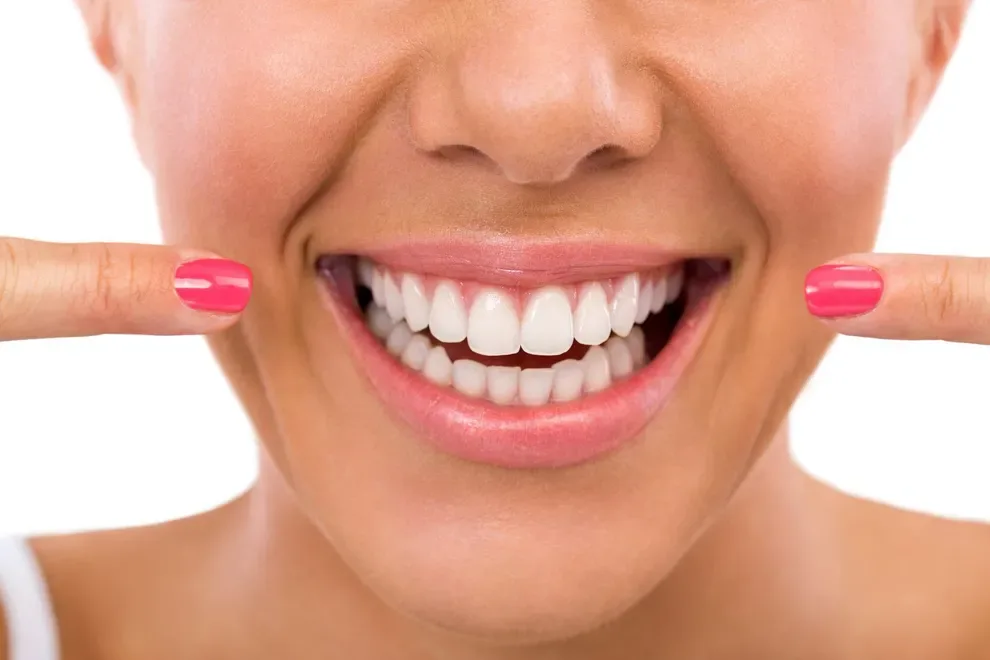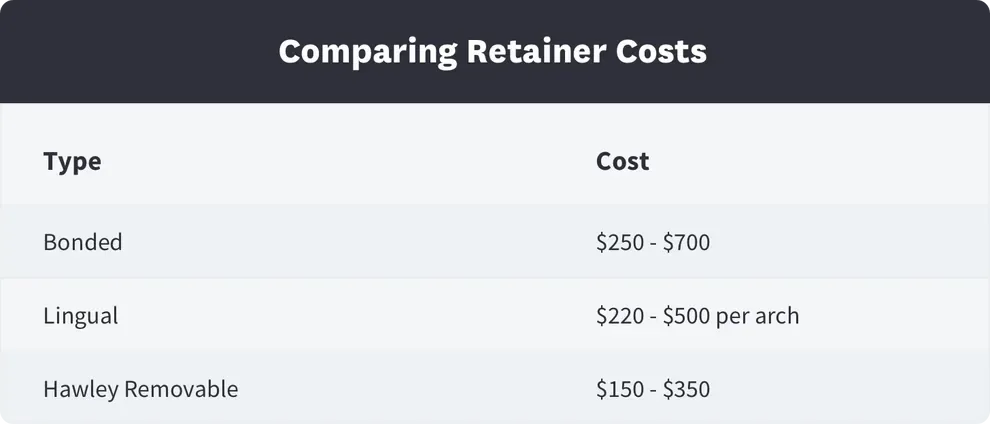Bonded Retainers - Uses, Costs, Pros & Cons

Table of Contents
- What are Bonded Retainers?
- Pros & Cons: Bonded Retainers vs. Other Retainers
- Costs
- Orthodontist Recommended Retainers
- Frequently Asked Questions
- References
What are Bonded Retainers?
A bonded retainer is a thin piece of wire glued to the back of your teeth. The retainer is designed to stop your teeth from shifting, spacing and growing crooked.
Your teeth are attached to your skull by tissue known as a periodontal ligament, which comprises a network of stretchy fibers that can move. Over time, a bonded retainer can reshape the ligament and underlying bone structure so that your teeth align in a planned order.
Like elastic, periodontal ligament can resume its original shape when the retainer is removed. That’s why orthodontists recommend bonded retainers as a permanent solution to prevent teeth from relapsing (moving back to their original positions).
Unlike a removable retainer, a bonded retainer is permanent, and it’s manufactured to last your entire life. It is adjusted to match your bite so that it doesn’t interfere with eating and doesn’t come off during chewing.
Bonded retainers are commonly placed on the back surface of the bottom teeth, in which case, the retainer becomes a “lingual wire.” Orthodontists attach this thin wire to the back of your cuspids (canine teeth) using bonding material that is designed to hold for decades.
Nevertheless, bonded retainers can come off in some cases, such as during routine tartar cleanups.
Once a retainer comes off, it can take as little as three months for teeth to relapse and move back into their original, ill-set positions.
Pros and Cons: Bonded Retainers vs. Other Retainers
The pros of a bonded retainer include:
It keeps your teeth permanently aligned. A bonded retainer keeps your teeth aligned for life.
It stays hidden. No one can see it when you smile or talk.
It doesn’t affect your speech or your eating. You can perform these activities as you normally do without feeling self-conscious.
There is no risk of losing it. It is permanently installed in your mouth.
It isn’t easily damaged. It is durable and adjusted to your bite.
Bonded retainers may not be the best option to align crooked teeth in the upper jaw. The thin wire also takes a little getting used to and can make simple dental hygiene tasks seem difficult.
Drawbacks of bonded retainers include:
They require extra effort to keep clean. With removable retainers, cleaning is easy since you can take them out and soak them in a cleaning solution. That’s not the case with bonded retainers, which you have to clean without seeing.
They make brushing and flossing more difficult. Brushing and flossing around a bonded retainer can be difficult, causing you to neglect proper oral hygiene and risk cavities and gum disease.
The attachment procedure is long and can be uncomfortable. Removable retainer molds are made in seconds, but the procedure for attaching a bonded retainer takes long and may involve pain and discomfort.
It can be loosened by some foods. Biting into hard foods like apples or eating tough steak can bend the lingual wire, making it less effective. Also, sugary drinks and foods that are high in artificial additives may dissolve the bonding material, loosening the retainer.
It can suffer physical damage. Even though it is designed to last a lifetime, a bonded retainer can come loose or break a wire, necessitating repairs or a replacement at extra costs.

Costs of Bonded Retainers
On average, bonded retainers may cost between $250 and $700 for initial placement or replacement. This should be a one-time cost. Once these models are in place, they should require little to no maintenance over time to hold their effectiveness.
Nevertheless, damages may incur a similar fee to repair or replace the bonded retainer.
A lingual wire goes for between $220 and $500 for one arch, whether the top or bottom. It is often made from titanium, nickel, copper, or a combination of these metals and can last indefinitely.
In comparison, the standard Hawley removable retainer costs between $150 and $350.
The cost of your retainer may be bundled together with the overall cost of the procedure. Your orthodontist sets their own prices, so it is important to discuss whether dental insurance covers parts of the procedure.
Retainers That Are Orthodontist Recommended
In general, there are two types of retainers: removable and permanent (bonded). Your dentist may recommend one or the other, or even both, depending on the position of the misaligned teeth.
A removable retainer may suit younger children, whereas a bonded retainer is a better option for adults who care about the aesthetics, convenience, and reliability it offers. Furthermore, bonded retainers are ideal for you if you consistently forget to wear removable braces.
For you to qualify for bonded retainers, your teeth must have sufficient surface area for the bonding material. Your orthodontist’s initial assessments will decide whether you’re a suitable candidate for bonded retainers.
Teeth can shift quickly after orthodontic therapy, so bonded retainers can be an effective short-term solution as well as providing a long term solution for preventing the shifting of teeth.
Bonded Retainer FAQs
Since bonded retainers are attached to the back of your teeth and cannot be removed at home, they are designed to last for decades. While it is possible to accidentally damage or slightly detach a bonded retainer, your dentist will be able to fix this promptly.
Your bonded retainer might not last as long as needed if it is under more stress than expected, like from chewing. Similarly, it might not last as long if it is put into place poorly or if teeth are not well cared for.
Bonded retainers not only help protect the alignment improvements that are the result of long-term treatment, but they also keep your teeth in proper alignment for a very long time.
This orthodontic device is specifically for people whose teeth are at high risk of shifting out of alignment, meaning they would need continuous orthodontic treatment throughout their lives, even if they had a removable retainer after the first round of treatment.
Your bonded retainer benefits from your oral healthcare routine. The first step is to brush your teeth as normal, potentially with a toothpaste that has fewer abrasive ingredients to help keep the glue in place longer.
You should also floss all your teeth. Your dentist will show you how to safely floss around the bonded retainer. This keeps your teeth as clean as possible, so your retainer will stay in place longer.
Even if you try to maintain a strong oral hygiene routine, a bonded retainer is an additional device in your mouth that can lead to an increase in plaque and calculus buildup. If you do not visit your dentist regularly enough, or if your mouth is simply more inclined to develop plaque, your bonded retainer can cause oral hygiene problems. This includes tooth decay.
Your bonded retainer may also not fit properly after a few years. This is rare, but the jaw can sometimes grow or shift, and this can lead to the bonded retainer being in the wrong place.
The bonded retainer should prevent your teeth from shifting, but they might begin to shift anyway. This can cause pain along the teeth or jaw where your retainer is bonded.
Your dentist can remove your bonded retainer if necessary. Going to regular exams allows your dentist to monitor any problems that your bonded retainer suffers from, so the retainer can be removed and adjusted, replaced with a new device, or even removed entirely.
Sometimes, the glue that bonds the retainer to your teeth disintegrates or breaks, so the retainer begins to come off on its own. Your dentist will try to put the retainer back in place but may need to remove the retainer and replace it. If your bonded retainer must come out and cannot be replaced with another bonded retainer, your dentist may recommend a removable retainer instead.
After many years, your dentist will determine that your treatment is done and will take the retainer out.
